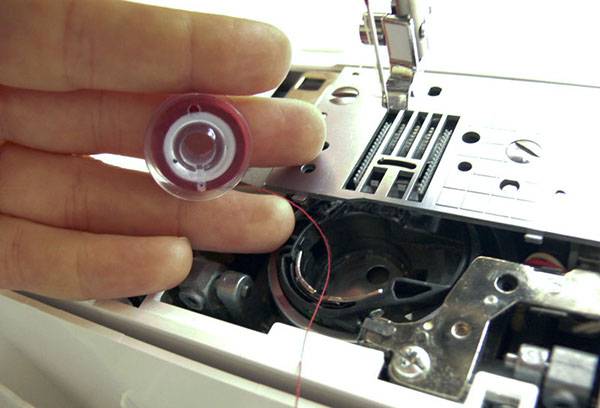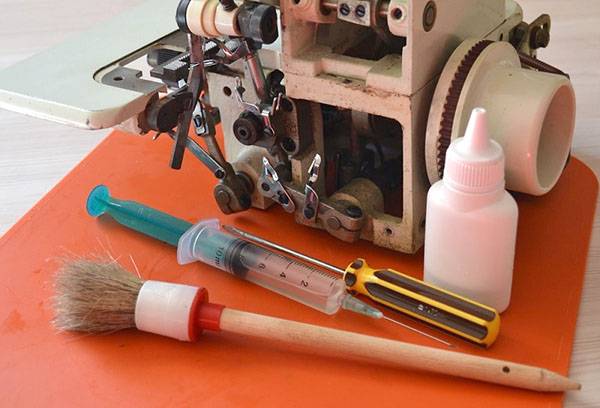Simple rules for caring for sewing machines
Of course, from the time of the first “Singer” care of the sewing machine has become much easier: if you use this technique occasionally for domestic purposes, you can not think about cleaning and lubrication for years, and the mechanism will work properly. But still, proper care is directly related to the life of the machine, so if you do not plan to change the machine in the next few years, we advise you not to forget about the following manipulations.
Cleaning the inside
One of the most common causes of breakdowns is clogging of the internal mechanism, resulting in jamming. But expensive repairs can be avoided by remembering dust removal in time. But wiping the casing and adjusters of the sewing machine with a cloth is not enough: you will have to clean the internal elements from fibers, scraps of threads and small pieces of fabric. This is done simply, and ideally, such cleaning can be carried out at least once immediately after completion of work. But for the lazy, not everything is lost: if the machine is not used too often, then you can take care of it 1-2 times every six months. What is the care at this stage?
Important!
If you often work with knitwear, fur or wool, you need to clean the machine more often, since these materials leave behind a large number of fibers that can quickly clog the mechanism.
- First of all, the machine must be disconnected from the network, and for safety and convenience purposes it is better to remove the needle.
- The needle plate must be unscrewed, the shuttle dismantled according to the instructions for your machine. It sounds complicated, but in fact, after the first cleaning you will understand that no special skills are required here.
- First of all, it will be necessary to clean the dust from the niche under the needle plate, the shuttle and the bobbin case, since the dirt mainly accumulates there.
- Dust is removed using hard and soft brushes, while for small and complex parts like a shuttle a soft brush is preferable.
- Wound threads and large pieces of fabric can be removed with tweezers, and it is convenient to pick up dust accumulations in the corners with a needle. It is only better to use its blunt end to avoid scratches on the mechanism.
- Another rule of care when cleaning: do not use a damp cloth out of habit. Oil and dust can be removed from parts only with a dry cloth, otherwise rust, which is already formed in small quantities, cannot be avoided.
Ignoring cleaning can lead to a malfunction of the fabric advancement mechanism and also increase the load on the machine drive, which can lead to more serious damage.
Tip
Dust can also get in through the controls of the sewing machine, so cleaning them from dirt is just as important, although this is just a small part of caring for the sewing machines.
To carry out cleaning as little as possible, it is advised to store the machine in a special case: so dust will have virtually no access to internal mechanisms. Well, in order to further protect the niche under the needle plate, before placing the machine in the case, put a dense fabric under the foot that will cover the needle holes.
Lubrication of parts
If sewing is your hobby and the machine does not work for days on end, then lubricate it enough once every six months or even a year. With modern cars, this should be done more quickly as a preventive measure in order to increase the operating life, although, of course, working on a greased machine will be much more pleasant.
- To begin with, you can lubricate the machine only after cleaning, which consists not only in cleaning from dust, but also in removing rust and old oil from the internal mechanism. They can be removed with a dry cloth by lifting the plastic cover.
- About how to properly carry out the lubrication process of your model, it is better than in the instructions, it is not said anywhere. Examine it before taking on the grease fitting: it is possible that your machine can only handle parts manually, or it may be enough to drop a couple of drops of oil into a special hole for lubrication.
- Lubricating oil is suitable only for special, machine. Other oils for caring for the sewing machine are not suitable, and it is better to buy a tool in a specialized store.
- After lubricating the internal elements, rotate the flywheel 2–3 times towards yourself so that it is not much better distributed over parts. You cannot use the machine right away, otherwise you will stain the fabric. We advise you to make a kind of oil drain by placing a cloth under the foot and lowering the needle into it. After a while, excess oil will drain into the fabric, and the machine will be ready for use.
- Regulators of the sewing machine also need lubrication from time to time: their metal base also begins to rotate worse and become covered with rust over time.
As you can see, caring for the sewing machine is not a big deal, and if you still don’t forget about changing the needles regularly, thread the thread correctly and don’t use the machine for jobs that exceed its capabilities, then your assistant will serve you very a very long time.


